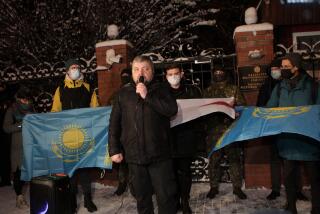COMMUNISM: R.I.P. : THE UNKNOWN LENIN: From the Secret Archives.<i> Edited by Richard Pipes, with David Brandenberger in collaboration with Yury A. Buranov, Russian edition editor (Yale University Press: $27.50, 256 pp.)</i>
- Share via
Western visitors to Russia are often surprised by the continuing presence of Vladimir Ilyich Ulyanov, otherwise known as Lenin. He remains in residence at the mausoleum in Red Square and his statues and portraits are found throughout the land. The Communist Party of the Russian Federation, whose presidential candidate, Gennady Zyuganov, recently polled 40% of the vote, affirms his legacy.
Communism is strongest in the backwaters of contemporary Russia--the villages and the old industrial centers--and can be expected to fade with the advance of democracy and a modern market economy. But a full victory over Leninist ideology also requires the replacement of Communist myths with historical fact: That is the purpose of the present volume.
Lenin is the unique survivor among the gods of the Soviet pantheon. Stalin’s reputation was badly damaged by Khrushchev’s revelations in the ‘50s and ‘60s and even more by those in the Gorbachev years (especially the gruesome statistics on the purges and the collectivization of the peasantry). But Gorbachev, like Khrushchev, continued to praise Lenin after he had acknowledged the appalling errors of Stalin.
Sometimes called “the last Leninist,” Gorbachev found a model for his own reform in Lenin’s New Economic Policy (1921-28). Yet even as he did so, the intellectuals used the new freedom of glasnost to produce film documentaries, novels and plays that traced the roots of Stalinism to Lenin’s ideas and practices. Their effort to find “the real Lenin” beneath the mountain of official hagiography received powerful support from Boris Yeltsin’s effort to destroy the Communist Party and its influence after the failed coup of August 1991.
One of Yeltsin’s measures was the opening up of party and state archives, which provided the Lenin documents reproduced with commentary and analysis in “The Unknown Lenin: From the Secret Archives,” edited by the distinguished Russian historian, Richard Pipes.
There is much in these documents that ought to disabuse those in Russia--and elsewhere--who continue to accept the myth of the good Lenin. One document contains an ominously simple sentence: “It is necessary secretly--and urgently--to prepare the terror.” With these few words, Lenin launched a program of arrests and executions that claimed tens of thousands of lives. He would soon introduce the first gulag, the harassment and suppression of dissident intellectuals, the suppression of religion, a forced regimentation of the country’s labor force and the mobilization of the country’s resources to support international revolution by every means available.
Faced with these documents, it is difficult to argue--as both communists and non-communists have done--that it was Stalin who invented a brutal and repressive Communist rule. These documents reveal that until their personal conflict in the last months of Lenin’s life, Stalin was the favored disciple and his appointment to the crucial post of general secretary of the party in 1922 reflected Lenin’s appreciation of his political views and administrative style.
When faced with peasant resistance to forced grain requisitions in Penza in Russia’s Volga region, Lenin’s order to the local Communists was: “Hang (hang without fail, so the people see) no fewer than one hundred known kulaks [rich peasants], rich men, bloodsuckers.” It is an enormous jump in the number of victims, but not in ideological fanaticism and intolerance, from this to Stalin’s later declaration: “War to the death against the peasants.” More over, Lenin displayed frequent indifference to the harsh methods of his subordinates, dismissing reports of the brutal treatment of White Army war prisoners and ignoring reports from Jewish Communists about pogroms conducted by the Red Army as it retreated from Poland.
Stalin’s savage attacks against religion and clerics also had their antecedents in Lenin’s policies. One document outlines Lenin’s plan for the confiscation of the treasures of the major abbeys, monasteries and churches. Writing in March 1922, in the midst of a famine that cost 5 million lives, he argued that the government needed the money for domestic and foreign policy purposes and that popular resistance would be minimal because “people are eating human flesh and hundreds if not thousands of corpses are littering the roads. . . .” One could take advantage of the passivity of a starving population “to crush the clergy with such brutality that it will not forget it for decades to come.”
Reading this document, more than any other, convinced Lenin’s biographer, Dmitri Volkogonov, that his subject was a cruel and heartless fanatic. In a time of widespread famine, the moneys gained were put aside for Communist Party purposes, including the funding of foreign parties. President Herbert Hoover was left to minister to the starving Russians and Ukrainians, though not without Lenin ordering mobilization of “the maximum number of communists who know English, to introduce them into the Hoover Commission and for other forms of surveillance and intelligence.”
One of the most powerful messages in these documents is Lenin’s overwhelming preoccupation with a Communist world revolution. The war with Poland was seen as a preparation for support of revolutionary war in Germany and Lenin remained naively confident as late as 1922 of the spread of revolution to Western Europe, including Great Britain. Events would prove otherwise.
Pipes and his American and Russian collaborators have produced an immensely valuable book, which adds much to understanding the character and impact of the most influential revolutionary of the 20th century. His comments on the history of Soviet management of the Lenin documentation, from Lenin’s time to the present, reveal much about Soviet information control. His brief biography of Lenin, as well as the thoughtful commentary and annotation of the documents, have created a fascinating book for both the general reader and the specialist.
More to Read
Sign up for Essential California
The most important California stories and recommendations in your inbox every morning.
You may occasionally receive promotional content from the Los Angeles Times.










